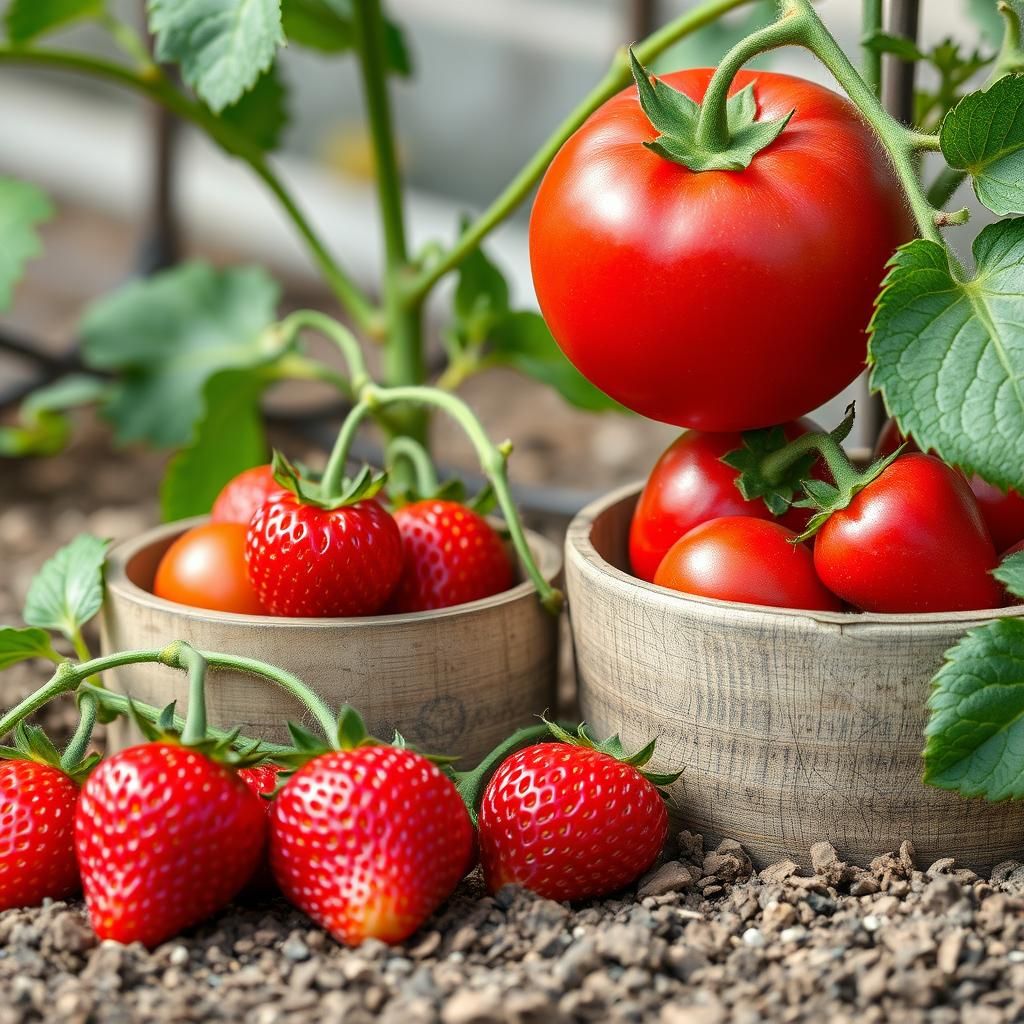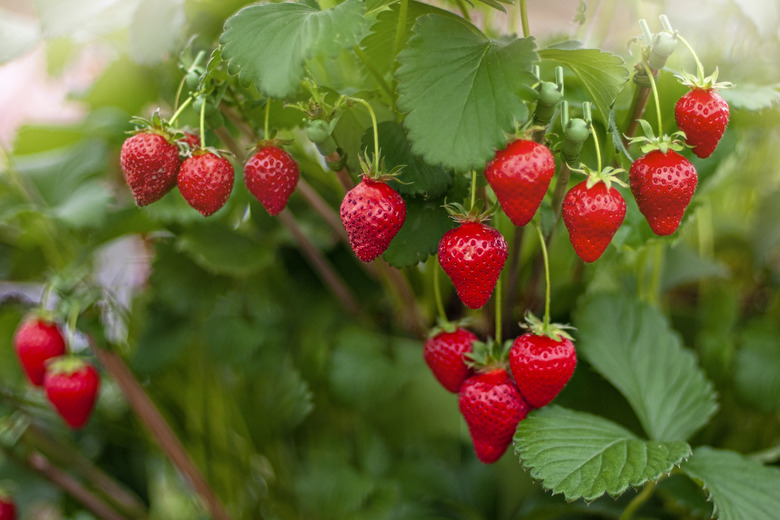Can You Plant Strawberries and Tomatoes Next to Each Other? Discover the Best Companion Planting Tips!

When planning your garden, the arrangement of plants can significantly impact their growth and yield. One common question among gardeners is whether strawberries and tomatoes can be planted next to each other. Companion planting is a gardening technique that maximizes space and enhances plant health by choosing compatible species. In this article, we will explore the benefits and potential drawbacks of planting strawberries and tomatoes side by side, along with essential tips for successful companion planting. Discover how to create a thriving garden ecosystem that promotes the growth of these delicious crops while maintaining optimal conditions for both.
Can You Plant Strawberries and Tomatoes Next to Each Other?
Planting strawberries and tomatoes next to each other can be a viable option in your garden, as they have different growth habits and nutrient requirements. However, it's essential to consider that tomatoes thrive in warm conditions while strawberries prefer slightly cooler temperatures. While both plants can benefit from similar soil types, competition for resources may arise if they're planted too closely. To successfully cultivate them side by side, ensure adequate spacing, monitor moisture levels, and be attentive to pests, as their companionship might attract specific insects that could impact their growth.
Compatibility of Strawberries and Tomatoes
The compatibility between strawberries and tomatoes is often debated among gardeners. While they do not negatively affect each other's growth directly, there are benefits to keeping their distance to avoid competition for sunlight and nutrients. Tomatoes can grow tall and may overshadow the strawberry plants, limiting their access to light. Therefore, while they can coexist, careful planning is required for optimal growth.
Soil Requirements
Strawberries and tomatoes have similar soil requirements, preferring well-drained, nutrient-rich soil with a slightly acidic to neutral pH. However, tomatoes generally require more nutrients, especially nitrogen, than strawberries. It is crucial to amend the soil adequately to support both plants, ensuring that strawberries are not overwhelmed by the nutrient demands of tomatoes, which could stunt their growth.
Watering Needs
When planting strawberries and tomatoes together, consider their water requirements. Tomatoes need consistent moisture but can tolerate drier conditions better than strawberries, which prefer evenly moist soil. Overwatering can lead to root rot, which is particularly harmful to strawberry plants. Hence, it’s vital to establish a watering routine that maintains the right moisture levels for both varieties without suffocating the strawberries.
Pest Management
Planting both strawberries and tomatoes can initially seem beneficial, as they may share pest enemies. However, this can also lead to specific pests targeting both plants, such as aphids. Monitoring for pests becomes increasingly important in a shared garden bed. Employing organic pest management strategies, such as companion planting with herbs like basil or using insecticidal soap, can create a balanced ecosystem that helps protect both crops.
Harvesting and Care
The harvesting schedules for strawberries and tomatoes differ significantly, which can make care more complex. Strawberries will typically produce fruit before tomatoes, requiring attention during their fruiting period. Plan your care routine to ensure that both plants receive adequate attention; be responsive to the strawberries when they are ready to be harvested, and then shift your focus to the tomatoes as they ripen later in the season.
| Factor | Strawberries | Tomatoes |
|---|---|---|
| Soil Type | Well-drained, nutrient-rich | Well-drained, nutrient-rich |
| Watering Needs | Evenly moist | Consistent moisture |
| Pest Sensitivity | Affected by aphids | Affected by aphids |
| Harvest Time | Spring-summer | Summer-fall |
How close can you plant tomatoes to strawberries?

When considering the proximity of tomatoes and strawberries, it is important to understand the potential competing needs of these plants. Tomatoes (Solanum lycopersicum) and strawberries (Fragaria × ananassa) can be planted in relative proximity, but careful planning is required to ensure both plants thrive. Ideally, it is recommended to maintain a distance of about 12 to 18 inches (30 to 45 cm) between the plants to prevent competition for resources such as nutrients, water, and sunlight.
Space Requirements for Tomatoes
Tomatoes require sufficient space for their roots to spread and for air circulation to prevent disease. When planting tomatoes:
- Consider Root Depth: Tomato roots can grow deep, requiring more space.
- Allow Airflow: Keeping sufficient distance helps improve airflow, reducing the chance of fungal diseases.
- Optimal Spacing: A spacing of 18 to 24 inches between tomato plants is ideal.
Space Requirements for Strawberries
Strawberries, although less demanding than tomatoes, still need adequate spacing to flourish and produce fruit. When planting strawberries:
- Consider Plant Form: Strawberry plants spread out and can crowd each other if not spaced correctly.
- Allow for Runners: Strawberries produce runners, which require space to grow without competing with other plants.
- Optimal Spacing: A spacing of 12 to 24 inches between strawberry plants is recommended.
Companion Planting Benefits
Tomatoes and strawberries can enjoy some benefits when planted in close proximity, but it’s essential to be cautious. The benefits include:
- Space Optimization: Planting both crops allows for efficient use of garden space.
- Pest Deterrence: Some studies suggest tomatoes can repel certain pests that harm strawberries.
- Insect Attraction: By planting both, you can attract beneficial insects that help in pollination.
Potential Issues with Proximity
Despite the advantages, there are potential issues when growing tomatoes and strawberries close together:
See also:
- Disease Transmission: Close proximity may facilitate the spread of diseases between the plants.
- Resource Competition: Both plants will compete for water and nutrients if planted too closely.
- Sunlight Blockage: Taller tomato plants can shade strawberry plants, limiting their light exposure.
Best Practices for Planting Together
To ensure both plants thrive when planted near each other, follow these best practices:
- Stagger Planting: Plant tomatoes on the northern side of strawberries to maximize sunlight for both.
- Regular Monitoring: Keep an eye on how each plant adapts; adjust spacing if necessary.
- Provide Support: Use stakes or cages for tomatoes to avoid overshadowing strawberries.
What should you not plant near strawberries?
:max_bytes(150000):strip_icc()/GettyImages-697462588-bac5dc98b31d472fbc0b91753aa9f47a-60e095f548a94e5bab896d7a6439d411.jpg)
Strawberries are a popular fruit crop that can thrive well in home gardens. However, certain plants can adversely affect their growth and yield. Understanding what not to plant near strawberries is crucial for maximizing their potential. Below are some plants and crops that should be avoided in close proximity to strawberries.
Brassicas
Brassicas, such as cabbage, broccoli, and kale, should not be planted near strawberries. These plants can release compounds into the soil that may negatively impact the strawberry plants' growth and health.
- Brassicas can compete for nutrients, leading to poor strawberry yields.
- They can attract pests that could also harm strawberry plants.
- These crops may lead to soil-borne diseases that could affect the strawberries.
Potatoes
Potatoes are another crop to avoid when planting near strawberries. While both are commonly grown in gardens, potatoes can harbor pests and diseases that may spread to strawberry plants.
- Potatoes can attract the Colorado potato beetle, which may also affect strawberries.
- They are susceptible to the same diseases, such as verticillium wilt, which could compromise both plants.
- Root competition can lead to insufficient nutrients for strawberries.
Mint
Mint is known for its strong aroma and flavor, but it is also an invasive plant that can overtake garden space, including that of strawberries.
- Mint can compete for water and nutrients, leading to reduced strawberry yields.
- Inefficiency in water and nutrient absorption can stunt strawberry plant growth.
- The aggressive spreading of mint roots can strangle strawberry roots.
Eggplants
Eggplants, like potatoes and tomatoes, belong to the nightshade family, which can lead to compatibility issues when growing strawberries nearby.
- Nightshade plants can share similar pest issues, increasing the risk of infestation.
- They may compete for essential nutrients, diminishing strawberry plant vigor.
- Both can be susceptible to the same soil-borne diseases, affecting strawberry health.
Walnut Trees
The juglone produced by walnut trees can be particularly harmful to strawberries and many other plants.
- Juglone can inhibit strawberry growth, leading to poor fruiting.
- Even decomposition of walnut leaves can introduce juglone into the soil.
- Proximity to walnut trees can lead to overall distress in strawberry plants.
What should not be planted next to tomatoes?
:max_bytes(150000):strip_icc()/Spruce_Companion_Plants_For_Tomatoes-b09296ce123143cbba06924494fffa98-8757a09df8a1461ea24f0e5e8013a58f.png)
When growing tomatoes, it is essential to consider companion planting to maximize growth and avoid pests and diseases. Some plants can negatively affect the health and productivity of tomatoes. Here are some plants that should not be planted next to tomatoes:
Plants that Attract Pests
Certain plants can draw insects that are harmful to tomatoes. These pests can lead to the spread of diseases and damage the plants.
- Pepper plants: These can attract aphids, which can spread to your tomato plants.
- Eggplants: Similar to peppers, eggplants can also bring in unwanted pests.
- Potatoes: They can attract Colorado potato beetles, which can harm tomato plants.
Alliaceae Family Plants
Members of the Alliaceae family, like onions and garlic, should be avoided near tomatoes. These plants can inhibit tomato growth by competing for nutrients and water.
- Onions: These can stunt the growth of tomato plants due to the competition for nutrients.
- Garlic: While beneficial in some cases, it can hinder the growth of tomatoes when planted too close.
- Shallots: Similar to onions, shallots also compete for resources.
Plants Requiring Similar Nutrients
Certain plants have similar nutrient requirements and can deplete the soil quickly when grown alongside tomatoes. This leads to poor growth and fruit development.
See also:
- Corn: Corn requires high nitrogen levels, similar to tomatoes, leading to nutrient competition.
- Carrots: They have similar needs and can affect the nutrient availability for tomatoes.
- Beets: Beets draw similar nutrients, potentially leaving tomatoes undernourished.
Plants Susceptible to Similar Diseases
Growing plants that are prone to similar diseases next to tomatoes can lead to easier disease transmission between them.
- Solanum species (such as peppers and eggplants): Same family as tomatoes, they can share diseases like blight.
- Strawberries: While they are not closely related, both can suffer from fungal diseases in humid conditions.
- Sunflowers: These can also attract pests and diseases that affect tomatoes.
Plants with Allelopathic Properties
Some plants release chemicals into the soil that can hinder the growth of nearby plants, including tomatoes. These plants possess allelopathic properties that negatively influence tomato development.
- Hellebores: Release toxins that can stunt tomato growth.
- Walnuts: Their leaves and roots contain juglone, toxic to tomatoes.
- Sweet potato vines: Can inhibit the growth of tomatoes through allelopathy.
Do strawberries and tomatoes go well together?

Strawberries and tomatoes can indeed complement each other in various culinary applications, although they might not be the most traditional pairing. Both are classified as fruits, and their contrasting flavors can create interesting and unique dishes. Strawberries bring a sweet and slightly tart flavor, while tomatoes offer a more savory and umami taste, which can lead to exciting combinations in salads, salsas, or even as a part of a dessert.
Flavor Profiles
The flavor profiles of strawberries and tomatoes are quite different but can be harmonized in certain dishes.
- Strawberries: These berries are known for their sweet and juicy characteristics, making them a popular choice in desserts and salads.
- Tomatoes: They possess a savory, slightly acidic flavor, which is iconic in sauces, salsas, and many savory dishes.
- Combination: When paired together, the sweetness of strawberries can balance the acidity of tomatoes, creating a refreshing taste experience.
Salad Pairings
Strawberries and tomatoes can be used together in salads to offer a vibrant color palette and diverse flavors.
- Mixed Greens Salad: Combine mixed greens, sliced strawberries, and cherry tomatoes for a fresh salad topped with a light vinaigrette.
- Feta Cheese: Adding feta cheese can enhance the flavor combination, as its saltiness pairs well with both fruits.
- Nuts: Incorporating nuts such as walnuts or pecans provides a crunchy texture that complements the softness of the fruits.
Recipes Ideas
There are many creative ways to pair strawberries and tomatoes in fun recipes.
- Salsa: Make a unique fruit salsa with diced tomatoes, strawberries, red onion, lime juice, and cilantro; perfect for topping grilled meats or fish.
- Bruschetta: Top toasted bread with a mixture of diced tomatoes, strawberries, basil, and balsamic reduction for an innovative twist on traditional bruschetta.
- Skewers: Create skewers with chunks of tomato and strawberries interspersed with mozzarella balls for a visually appealing appetizer.
Nutritional Benefits
Both strawberries and tomatoes provide significant health benefits and are rich in essential nutrients.
- Vitamins: Strawberries are high in vitamin C, while tomatoes provide vitamins A and K, contributing to overall health.
- Antioxidants: Both fruits contain antioxidants that help combat oxidative stress in the body.
- Low Calorie: They are low in calories, making them excellent choices for anyone looking to maintain a healthy diet.
Pairing with Other Ingredients
When cooking with strawberries and tomatoes, consider other ingredients that enhance their flavor when paired.
- Herbs: Fresh herbs like basil or mint can elevate the dish, adding aromatic qualities.
- Citrus: A splash of citrus juice or zest can brighten up the flavors of both fruits.
- Spices: Spices such as black pepper or chili flakes can add an interesting kick and enhance the overall profile of the dish.
Questions from Our Readers
Can strawberries and tomatoes be planted together in the garden?
While it is possible to plant strawberries and tomatoes together, it is not always recommended due to differences in their growing requirements and potential for disease transmission. Tomatoes prefer warmer conditions and require more nutrients, while strawberries thrive in slightly cooler temperatures.
What issues can arise from planting strawberries and tomatoes side by side?
Planting these two crops next to each other may lead to competition for nutrients and space. Additionally, both plants can be susceptible to specific pests and diseases that could easily spread from one to the other, potentially affecting the overall health of your garden.
Do strawberries and tomatoes attract the same pests?
Yes, strawberries and tomatoes can attract some of the same pests, such as aphids and spider mites. This overlap can create a problem if both crops are planted close together, as any pest infestation could quickly spread from one plant to the other, making pest management more challenging.
What are the benefits of companion planting strawberries and tomatoes?
Some gardeners advocate for planting strawberries and tomatoes together because companion planting can help maximize space and may create a microclimate that benefits both plants. Additionally, diversifying your garden can deter certain pests and help promote a more balanced ecosystem, even if the specific pairing of strawberries and tomatoes may require careful attention.
See also:

If you want to read more articles like Can You Plant Strawberries and Tomatoes Next to Each Other? Discover the Best Companion Planting Tips!, we recommend you check out our Garden category.
Leave a Reply
Related Articles